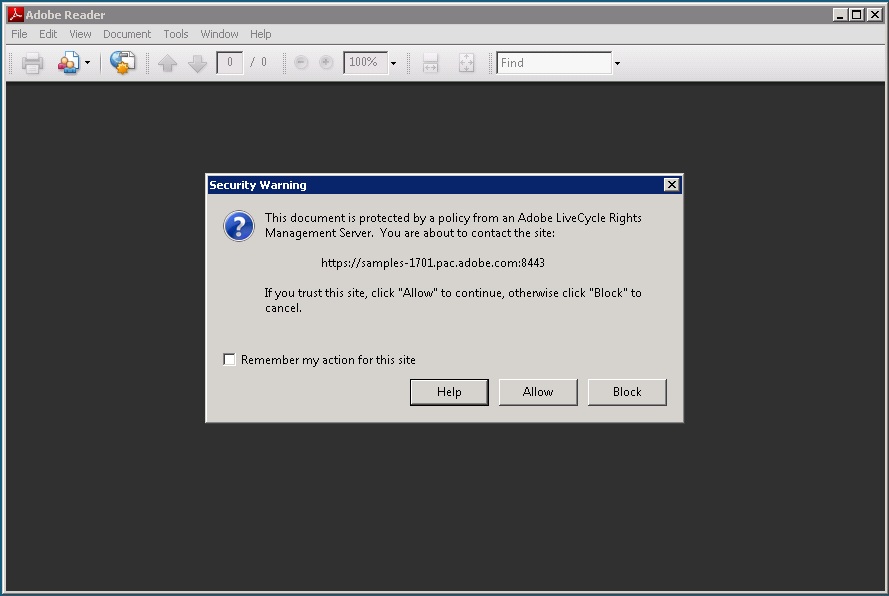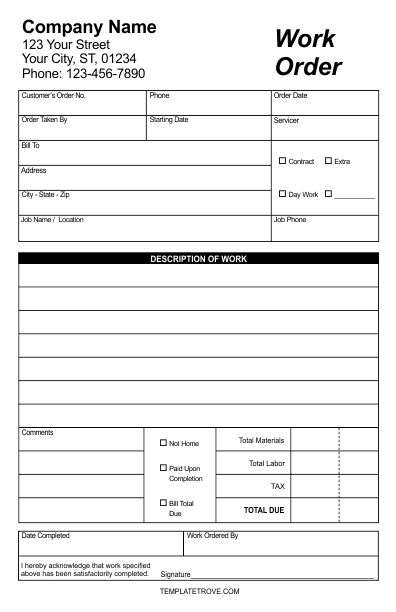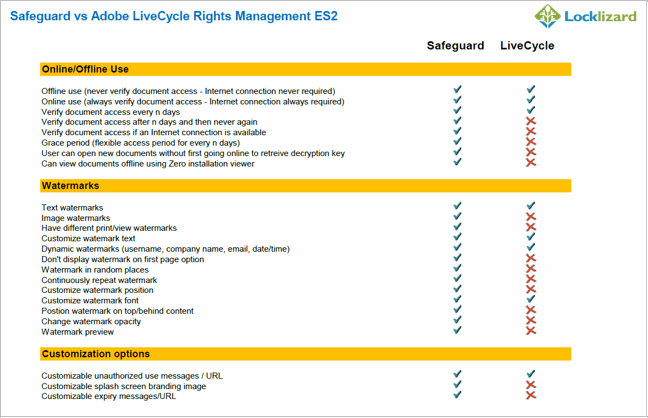- Adobe Livecycle Rights Management Es4
- Adobe Livecycle Designer Purchase
- Adobe Livecycle Rights Management Es
1) The Adobe LiveCycle Portable Protection Library which is a C SDK that allows programmatic access to the Rights Management component of your Adobe LiveCycle instance. Because PDFBox is Java, you'll need some way of wrapping that library.
Name: LiveCycle Rights Management ES
Description:
Price: $120/per recipient
- Adobe LiveCycle Rights Management ES4 introduces Page 0 (Wrapper Document) support for Policy protected documents in Adobe LiveCycle ES4 release. In case of most of the non-Adobe PDF viewers, on opening LCRM protected documents a blank screen appears or the application aborts. Continue reading →.
- Adobe LiveCycle Rights Management provides dynamic watermarking capabilities on PDF documents. A watermark is an image that is superimposed over the original base document. In a rights managed document, the image can be applied dynamically as the document is viewed in.
- Applying policies by using other applications, such as Microsoft Office, is documented in the Rights Management Extension Help for the application. You can download the LiveCycle Rights Management Extension for Microsoft Office from the Adobe website. Note: Rights Management requires authentication over SSL connections.
- Adobe LiveCycle ES4 SP1 (11.0.1) Important: LiveCycle QFs are cumulative, which means they include issues fixed in previous QFs.Therefore, before installing this QF, it is recommended to go through all the previous QFs for LiveCycle ES4 SP1 Rights Management QFs.
Quick Read
Rating Breakdown
SC Labs Reviews
Reviews from our expert team

Features:
Documentation:
Value for Money:
Performance:
Support:
Ease of Use:

Summary
Adobe LiveCycle Rights Management ES is a client-server-based digital rights management (DRM) product that integrates with most existing infrastructure, including directory systems, operating systems and databases. The tool allows organizations to create enforcement and control policies on a document basis to prevent printing, editing and copying for file types. LiveCycle can also provide dynamic watermarking for additional protection to add information, such as username, IP address, or even policy name. Embedded metadata in files allows them to link back to policies on the server with a centrally managed interface so users and/or administrators can change or edit policies in real time to remove or add users and groups.
Installation and deployment is quite straightforward. The installation is guided by an in-depth setup wizard, which installs the server software, as well as the application server needed by the product. At the end of installation, a second wizard is launched, which assists with initial configuration and deployment. After installation, the product applications are also simple and intuitive to use.
LiveCycle uses an application and web server to host documents. This allows for a great amount of flexibility and transparency to the end-user.
Documentation was comprised of a number of well-organized PDF guides. However, there were just too many. We would like to see them consolidated for better ease of searching.
Adobe offers an online knowledge base as free technical support. Enterprise-level support can be obtained through support contracts at a price of 20 percent of the license fee. This support includes phone and email technical support 24/7.
Adobe LiveCycle Rights Management ES pricing varies based on the number of users/recipients and forms. Volume discounts apply. With a price starting at $120 per recipient, this product can become expensive. However, we do find it to be a good value for the money based on its ability to control the entire document management process.
Rights Management ensures that only authorized users can use your documents. Using Rights Management, you can safely distribute any information that you have saved in a supported format. Supported file formats include:
Adobe PDF files
FLV and F4V files for Adobe Flash®
Microsoft® Word, Excel, and PowerPoint files
Parametric Technology Corporation (PTC) Pro/ENGINEER Wildfire 4.0 files
For more information about how policies protect supported file types, see Additional Rights Management Information.

Using Rights Management, you can easily create, store, and apply predefined confidentiality settings to your documents. To prevent information from spreading beyond your reach, you can also monitor and control how recipients use your documents after you distribute them.
You can protect documents by using policies. A policy is a collection of information that includes confidentiality settings and a list of authorized users. The confidentiality settings you specify in a policy determine how a recipient can use a document to which you apply the policy. For example, you can specify whether recipients can print or copy text, edit text, or add signatures and comments to protected documents.
Rights Management users create policies through the end-user web pages. Administrators use the Rights Management web pages to create policy sets that contain shared policies that are available to all authorized users.
Although policies are stored in Rights Management, you apply them to documents through your client application. How to apply policies to PDF documents is described in detail in Acrobat Help. Applying policies by using other applications, such as Microsoft Office, is documented in the Rights Management Extension Help for the application.
Adobe Livecycle Rights Management Es4
When you apply a policy to a document, the confidentiality settings specified in the policy protect the information that the document contains. The confidentiality settings also protect any files (text, audio, or video) within a PDF document. You can distribute the policy-protected document to recipients who are authorized by the policy.

Document access control and auditing
Using a policy to protect a document gives you ongoing control over that document, even after you distribute it. You can monitor the document, make changes to the policy, prevent users from continuing to access the document, and switch the policy that is applied to the document.
Through Rights Management, you can monitor policy-protected documents and track events, such as when an authorized or unauthorized user attempts to open the document.
Components
Rights Management consists of a server and user interface:

Adobe Livecycle Designer Purchase
Server: The central component through which Rights Management performs transactions such as user authentication, real-time management of policies, and application of confidentiality. The server also provides a central repository for policies, audit records, and other related information.
Web pages: The interface where you create policies, manage your policy-protected documents, and monitor events that are associated with policy-protected documents. Administrators can also configure global options such as user authentication, auditing, and messaging for invited users, and manage invited user accounts.
The steps in the illustration are as follows:
Adobe Livecycle Rights Management Es
The document owner creates policies using the web pages. Document owners can create personal policies that are accessible only to them. Administrators and policy set coordinators can create shared policies within policy sets that are accessible to authorized users.
The document owner applies the policy, and then saves and distributes the document. The document can be distributed by email, through a network folder, or on a website.
The recipient opens the document in the appropriate client application. The recipient can use the document according to its policy.
The document owner, policy set coordinator, or administrator can track documents and modify access to them using the web pages.
